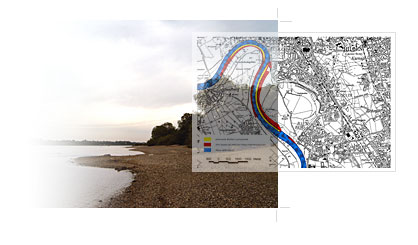In the first project year 2007 all potential spawning and stocking sites in the Rhine System will be determined. In the mapping of spawning habitats special attention will be given to water velocity, substrate conditions and water depth. For the determination of potential stocking sites the accessibility, food availability and protection from predators and shipping are the crucial factors.

29 inner curves + additional stretches in the Rhine in North Rhine Westfalia.
+ additional habitats in the lower parts of some tributaries ( e.g. Sieg 0.45 km2 until the first weir in Buisdorf, River Wupper, River Lippe)
Left: Possible spawning habitat [ Enlarge Photo ]
Right: Mapping of potential spawning and stocking sites [ Enlarge Picture ]
These investigations were conducted in France by the French partner in the project, CEMAGREF as well as at the Limnological Institute of the Universität Konstanz in the early summer of 2008. These studies were overseen by Eva Lages (Hogeschool Van Hall Larenstein, the Netherlands). Two different experimental approaches were tested.
1. Obstacles to migration in rivers cause the allis shad to spawn in suboptimal spawning areas downriver of the obstacles. The substrate is often fine-grained and the allis shad cannot settle in the gaps in a gravelly substrate system. It was assumed that the allis shad drift away in the current and are exposed to an elevated mechanical stress. This issue was investigated in France. The CEMAGREF Research Institute specialises in doing research on migratory fish. The SCOLA (Structure expérimentale d'étude du COmportement LArvaire) test facility was developed in order to be able to examine the early life stages of various species of fish more accurately. This closed circuit facility makes it possible to test egg and larva investigations under precisely defined environmental conditions. Allis shad were exposed there in three different substrates and the hatching rates were determined. Photo: SCOLA diagram [ Enlarge Photo ]
2. The Rhine is one of the most travelled shipping routes in Europe. Waves are regularly created by passing ships. These waves impact the bank and create a surge there. Scientific research on other rivers was able to demonstrate that young fish could become stranded on the bank under certain conditions or could be influenced in their behaviour. Photo: Wave at the shoreline [ Enlarge Photo ]
This problem was investigated in the wave effect mesocosms of the University of Konstanz. For this purpose, allis shad larvae were transferred to the testing facility and the behaviour of the animals in the presence and absence of wave events was recorded by a computer programme. In addition to this, possible incidences of stranding on the banks of the mesocosm were evaluated. Photo: Wave action of the University of Konstanz mesocosm. Eva Lages records allis shad behaviour by means of a laptop. Photograph. P. Beeck [ Enlarge Photo ]